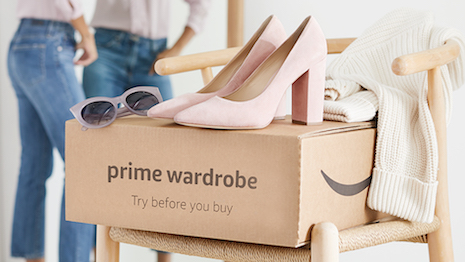 More online shoppers are purchasing apparel on a weekly basis. Image credit: Bloomingdale's
More online shoppers are purchasing apparel on a weekly basis. Image credit: Bloomingdale's
As clothing becomes one of the fast-growing sectors in ecommerce, consumers are also shopping online for apparel at a greater frequency.
According to the 2019 U.S. Forecast on Apparel Shopping Trends from Elite SEM's CPC Strategy, the majority of millennial and Gen Z shoppers are purchasing apparel from ecommerce giant Amazon more than any other Web site. While many luxury fashion brands have steered clear of Amazon, the platform is becoming a bigger player in apparel retail, particularly among younger consumers.
“Our most surprising finding was the extent to which younger shoppers, namely Gen Z and millennials, purchase apparel from Amazon and directly from a brand’s Web site,” said Nii Ahene, chief operating officer and cofounder of CPC Strategy, San Diego. “Fast shipping, easy returns and a growing marketplace of brands with competitive pricing and reviews make Amazon the go-to Web site for these shoppers.
“Young shoppers are also buying apparel directly from brand Web sites, which speaks to how brand investments in digital equity – be it through storytelling, lifestyle advocacy or a unique experience – can really pay off with Gen Z and millennials,” he said.
CPC Strategy's report was based on a November 2018 online survey of more than 2,000 consumers aged 18 to 65.
Amazon leads ecommerce
The ecommerce apparel market is expected to reach $118 billion in 2019.
From 2017 to 2018, the percentage of consumers who shop online for clothing at least once a month jumped from 14 percent to 18.3 percent. Almost 6 percent consider themselves “frequent” ecommerce shoppers and purchase apparel online at least once a month.
Younger shoppers are embracing casual clothing. Image credit: Gentle Monster
Casual wear also continues to grow in popularity, and consumers are more willing to experiment with new brands within that category.
Nearly 60 percent of all fashion shoppers purchased casual wear pieces within the last six months, followed by activewear purchases from 31.5 percent of respondents.
Seventy percent of Generation Z, defined by CPC Strategy as consumers between 18 and 24 years old, have made casual wear purchases. Meanwhile, 26.5 percent of millennials aged between 25 and 34 years have purchased workwear and less casual clothing.
Both demographics, however, make the majority of their clothing purchases on Amazon.
Fifty-seven percent of millennials and 63.4 percent of Generation Z have purchased apparel from Amazon, outpacing other age groups.
Amazon leverages fast shipping, lower price points and an intuitive user experience to attract younger shoppers looking to spend on fashion.
In recent years, Amazon has been making a bigger push into fashion by introducing more private labels. It also continues to undercut the traditional bricks-and-mortar model with the introduction of a try-before-you-buy service, dubbed Prime Wardrobe (see story).
Amazon Prime Wardrobe offers a try-before-you-buy payment method. Image credit: Amazon
More than a third of Gen Z consumers have also bought apparel directly on a brand Web site, compared to an average of 25 percent across all other generations.
CPC Strategy cites prior research that shows shoppers spend more on monobrand sites than on multibrand platforms such as Amazon.
Online luxury shifts
Luxury consumers are also increasingly turning to digital channels for shopping and trend expertise.
Presenting at Luxury FirstLook 2019: Digital Acceleration on Jan. 16, a partner from Boston Consulting Group discussed how generational differences continue to impact luxury brands.
Within the next five years, millennial and Chinese consumers will dominate luxury demographics. Younger affluents are embracing new luxury values, such as fun, creativity and personal expression, as reflected in the shift from heavy spend on luxury accessories towards ready-to-wear.
Online, mobile purchases continue to prevail over personal computers, and mobile commerce is expected to grow. Smaller high-end brands, however, need to make more active efforts to optimize for mobile (see story).
Revenue in fashion ecommerce continues to increase across devices, despite consumers actually spending less time shopping online through briefer mobile sessions.
According to a new report from ecommerce platform Nosto, the average revenue per visit (RPV) increased globally by 33 percent on desktop and 38 percent on mobile from the beginning to end of 2018. However, online fashion shoppers still spend more time browsing on desktop than mobile devices (see story).
“Shopping channels matter for all types of clothing, luxury included,” CPC Strategy's Mr. Ahene said. “You need to be present in the channel your target demographic is frequenting.
“Most legacy consumer apparel brands are not doing enough with their online shopping experience to clearly differentiate their offering from mass alternatives,” he said. “In order to avoid a similar outcome, luxury brands must invest resources to connect with their audiences where they are, particularly on mobile platforms and applications like Instagram.”

